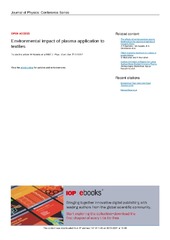Приказ основних података о документу
Environmental impact of plasma application to textiles
| dc.creator | Radetić, Maja | |
| dc.creator | Jovančić, Petar | |
| dc.creator | Puač, N. | |
| dc.creator | Petrović, Zoran Lj | |
| dc.date.accessioned | 2021-03-10T10:46:53Z | |
| dc.date.available | 2021-03-10T10:46:53Z | |
| dc.date.issued | 2007 | |
| dc.identifier.issn | 1742-6588 | |
| dc.identifier.uri | http://TechnoRep.tmf.bg.ac.rs/handle/123456789/1146 | |
| dc.description.abstract | Plasma technology is currently implemented in a wide range of industrial processes due to high efficiency, low environmental impact and simplicity. Low-temperature plasma treatment can be an alternative to traditional wet processes in textile preparation and finishing, causing modification of the fibre surface, which is mainly responsible for the material end-use properties i.e. wettability, dyeability, printability, shrinking, pilling etc. Appropriate choice of gas and control of plasma operation conditions provide a variety of effects on textiles (improvement of dyeability, printability and colour fastness, improvement of adhesion properties of coated fabrics, increase in hydrophobicity and water resistance, etc.). However, in spite of extraordinary efficiency, multifunctionality and simplicity, low-temperature plasma treatments still cannot replace all wet finishing processes, though they can be viable pretreatments that offer plenty of environmental and economical benefits. | en |
| dc.publisher | IOP Publishing Ltd, Bristol | |
| dc.rights | openAccess | |
| dc.source | First International Workshop on Nonequilibrium Processes in Plasma Physics and Studies of Environmen | |
| dc.title | Environmental impact of plasma application to textiles | en |
| dc.type | article | |
| dc.rights.license | ARR | |
| dc.citation.other | 71: - | |
| dc.citation.volume | 71 | |
| dc.identifier.doi | 10.1088/1742-6596/71/1/012017 | |
| dc.identifier.fulltext | http://TechnoRep.tmf.bg.ac.rs/bitstream/id/47/1143.pdf | |
| dc.identifier.scopus | 2-s2.0-34547149626 | |
| dc.identifier.wos | 000251412900017 | |
| dc.type.version | publishedVersion |

